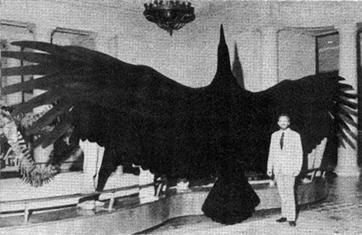
Thunderbird
This reports comes to us from Katie. Thanks for submitting the sighting.
-Start Report-
Name: Katie
State: Iowa
County: Boone
Date of Sighting: October 2, 2013
Time of Day: 6:50 a.m.
Nearest Town: Ames
Length of Sighting: 1 minute
How many Witnesses: 1 (although 2 police cars were stopped nearby and could have seen as well)
Any Photos/Videos: No
Describe sighting in detail: My husband was driving home early this morning, and pulled off of Highway 30 on the last exit headed west for Ames, Iowa. He said he got to the top of the exit ramp, turned right and came up to another stop sign on Lincoln Highway. He stopped the car there instead of proceeding because he said he saw a giant black bird take off from the ground in a cornfield across the road. He said the wingspan was around 40 feet wide and the body enormous (bigger than small planes). He said he'd never seen anything like it. He said it just flew off up into the clouds and disappeared. He said it wasn't a very graceful flier either. He didn't want anyone to know, but upon further research, it seems that these sightings have happened in Iowa before and all over the country throughout history. I thought I would report his sighting to you (exactly what he told me) to let others know and to be on the lookout in the Ames area for this bird again.
-End Report-
The Legend Of The ThunderbirdThe thunderbird is a legendary creature in certain North American indigenous peoples' history and culture. It is considered a supernatural bird of power and strength. It is especially important, and frequently depicted, in the art, songs and oral histories of many Pacific Northwest Coast cultures, and is found in various forms among the peoples of the American Southwest, Great Lakes and Great Plains. Thunderbirds were components of the Southeastern Ceremonial Complex of American prehistory
The thunderbird's name comes from the common belief that the beating of its enormous wings causes thunder and stirs the wind. The Lakota name for the thunderbird is Wakį́yą, from wakhą, meaning "sacred", and kįyą, meaning "winged". The Kwakwaka'wakw have many names for the thunderbird, and the Nuu-chah-nulth (Nootka) called it Kw-Uhnx-Wa. The Ojibwa word for a thunderbird that is closely associated with thunder is animikii, while large thunderous birds are known as binesi.
Wikipedia
Demonic cloak or ... hallucination? With the NWO around the corner and the Illuminati marking the 21st Century the Beast's reign, more and more of these sightings will pop up because the hell spawns are salivating over the Apocalypse on Earth's ground. Better believe it or at the very least, consider it.